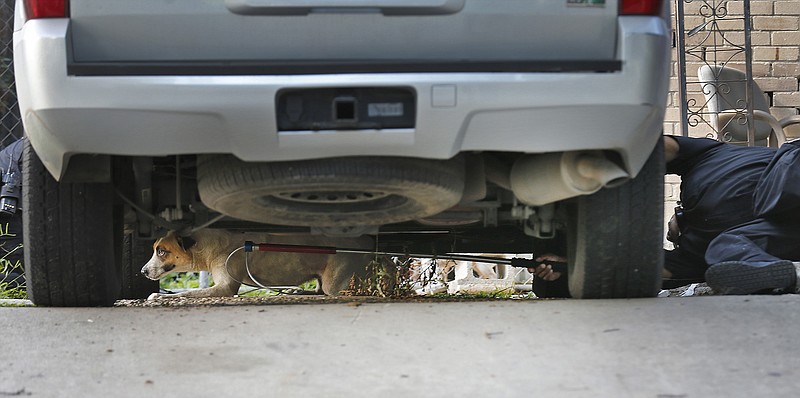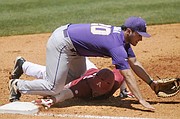SAN ANTONIO-As the director of Austin Pets Alive!, Ellen Jefferson gets a lot of urgent phone calls. Agency heads from municipal animal shelters across the country want to know how her nonprofit group, which adopts the sickest, least-loved dogs and cats, helped to make Austin the largest city in America with "no kill" shelters.
In 2011, one of those calls came from San Antonio.
"I walked into a city that was only saving about 30 percent of their animals," said Jefferson, who agreed to open a San Antonio chapter of Pets Alive! the next year.But things were changing. After decades of official neglect and public indifference, the Alamo City had begun to turn around its poor record of saving unwanted pets. In 2004, the old city shelter at Brackenridge Park euthanized more than 50,000 dogs and cats, the highest per-capita rate in the country.
Two years later, then-Mayor Phil Hardberger issued a challenge to significantly reduce the problem with strays. The City Council approved a plan to make San Antonio a "no-kill" city, which commonly means saving at least 90 percent of the unwanted animals.
A new city shelter with space for 22,000 animals opened in 2007 on the South Side. By November 2011, the city was saving more pets than it was killing. And by 2012, the kill total had declined to 13,559.
Since then, in big and small ways, multiple changes brought San Antonio to its first "no kill" status in December.
Money was key. The ACS budget nearly tripled in a decade, from $4.8 million in 2006 to $12.5 million this fiscal year. National animal groups like the Humane Society, the Petco Foundation, PetSmart Charities and ASPCA found money for San Antonio ACS projects.
The ACS embraced animal adoption groups, hired new staff, blanketed area schools and walked door-to-door in the city's toughest neighborhoods to promote responsible pet ownership. Education became as important as enforcement.
There are critics. Some animal-rights activists say the no-kill threshold should not have taken 10 years after the problems were identified. They still find it unacceptable that 10 percent of cats and dogs-primarily the sickest, oldest, most-injured and ill-behaved-are put to death."It is commendable that we are saving more animals," said John Bachman, co-director of VOICE For Animals, in an email to the San Antonio Express-News. "However, the city's preoccupation with the 90 percent live-release rate and No Kill distracted from what should be the overall objective-no more homeless pets. That means no more strays on the streets menacing people and getting killed by cars."
Animal Care Services has estimated that more than 150,000 stray dogs and cats roam the city.
Despite their efforts, ACS officials acknowledge that every month, dozens of healthy dogs also are put to death because other available options have been exhausted. Last year the ACS euthanized 4,448 animals, and something called the "5 p.m. list"-those animals who will be killed-must still be compiled each day by a staff member.
"What makes that manager's job so difficult is the awareness that this isn't the animal's fault," said ACS outreach director Lisa Norwood. "This is a people problem."
Animal shelter experts and city management publications have praised the San Antonio turnaround. Several cities-Houston, Dallas, Corpus Christi, Baton Rouge and Las Vegas, among them-have sent people to study the San Antonio experience.
"They're no longer just animal catchers in San Antonio," said Katie Jarl, the Texas state director of The Humane Society of the United States. "This is now a sophisticated operation dedicated to keeping more animals out of the shelters to begin with."
City Manager Sheryl Sculley said she counts the "heartening" change in ACS as one of the five most important accomplishments of her 11-year tenure here.
It was not a quick transformation, said City Councilman Rey Saldana, who had his animal welfare epiphany in 2011, shortly after being elected.
"I was raised on the South Side and just thought that dangerous dogs running in packs was a fact of life. I actually owe it all to my wife," he said. "She changed me 180 degrees on this. I told the city manager we needed to go door-to-door and talk to people about dogs. We had a terrible problem."
"We had to change our image," said Kathy Davis, who became the ACS director in 2012 and recently retired. "Before you ask the city to trust you, you have to clean up your own house first. We all knew the goal, but you don't become a no-kill city overnight."
Some ACS staff cautioned the public not to fixate on the "no-kill" number, itself a misleading term. With warmer months and the breeding season, the percentage dipped slightly below 90 percent for the total live-release in April and May, a figure that includes all healthy and unhealthy animals. If current adoption levels remain constant, as more animals come to ACS, more will fail to find a home and will be euthanized.
"We will not simply keep animals in the shelter, in a cage, for months, so that we can say we didn't euthanize them," Norwood said. "That's not humane treatment."
Davis and others track the start of the reform efforts to a San Antonio Express-News investigative report, "Death By The Pound," in November 2004, by then-Staff Writer Lisa Sandberg, who documented the slaughter at its height. On her first day as director in August 2012, Davis said, an ACS board member handed her a copy of the story.
"It was eye-opening," she said.
Among the grim facts: Almost nine of every 10 cats and dogs that entered the pound were put to death, many within an hour. Critiques of ACS by outside consulting agencies were ignored. Some staffers reported being traumatized from killing thousands of animals in a gas chamber and hearing their wails.
The city stopped using gas and switched to injections in the wake of the story. One year later, in November 2005, Sculley became city manager.
"I'm a runner," recalled Sculley. "And I was amazed back then at the number of stray animals throughout the city. I used to always carry pepper spray for the dogs. . Ten years ago, our ACS people were taking one ton of animal carcasses to the landfill each day, in plastic garbage bags."
In 2006, after hearing stories about children and the elderly being mauled in San Antonio by loose dogs, Sculley convened an ACS advisory board that put together a five-year plan. The goal was to be a no kill city by 2012.
"We had to change a culture about dogs," Sculley said. "Many people just viewed their dogs as security for their property. Nothing more. I remember that there used to be people who before Spring Break would just bring their dog and turn it in to the pound. . They'd say, 'We'll just get another one when we come back.' And that dog would be put to death."
Progress was slow. But the numbers did improve.
From 2006 to 2011, ACS increased annual citations from 550 to 5,000, spay-neuter surgeries rose from 8,000 to 52,000 and the department tripled its live-release rate to 31 percent.
Animal advocates such as Bachman say the city must treat its dog population problem like an epidemic and boost spay-neutering to about 100,000 animals per year for several years to achieve zero growth.
The city studied what worked at other animal shelters and identified three areas: strong enforcement, an aggressive spay-neuter program and active partnerships with major animal groups to increase adoptions.
That's where Ellen Jefferson and San Antonio Pets Alive!, plus groups like the Animal Defense League and Humane Society, have become indispensable. From 2012 through 2015, SAPA took in 26,310 of the toughest-to-adopt cats and dogs-animals with amputations, behavior problems, the elderly-and found homes for them.
"The Pets Alive! model is only focused on the city shelter and the animals who are left behind in the normal adoption process," Jefferson said. "So, if the city is doing a great job at adoptions, then Pets Alive! will really have a small pet population."
But SAPA needs money, too. It has a staff of 45 yet handles a similar number of animals as its Austin chapter, which has a staff of 100. If SAPA and similar groups do not fully function in San Antonio, then ACS says its no kill status will not be sustainable.
"My goal is to raise about a half million to one million dollars for three years running," Jefferson said. "There is simply too much work for us to do in San Antonio with the people we have. That leads to a poor adoption process, a poor fostering experience."
Like many who have dealt with ACS over the years, Jefferson agrees that the institutional change in a few short years has saved tens of thousands of animals.
At the 42,000-square-foot ACS shelter, the buildings are clean and airy, the workers appear busy and motivated. (Dozens of ACS staff have adopted or fostered pets.) Last week, veterinarians were doing more than 70 spay-neuter surgeries a day, yet the clinic was hardly chaotic. Enforcement officers quietly monitored calls throughout the city on big TV screens, yet only one flashed red, meaning a dog bite had been reported.
A herd of happy "community cats"-they don't say "feral" much at ACS-relaxed in the sun on benches. The adoption area was teeming with kids nuzzling puppies.
On a recent Saturday morning, several ACS staffers, volunteers and enforcement officers walked through one of the city's highest-need neighborhoods, handing out information about free spay-neuter programs and reminding residents that their dogs must be behind fences or leashed, must have their rabies shots and, as of 2015, all dogs and cats must be micro-chipped.
In the 400 block of Peabody, ACS health program specialist Jesse Enriquez, a tall engaging guy who has been doing this more than 20 years, bounded from one side of the street to the other to shake hands with residents.
"Loose dogs are still a problem here," said Maria Godina, a bit timid at first, in Spanish. "They bother people going to the senior citizens center. I go there, too. They should teach people about their dogs."
At the corner of Peabody and Creighton, two small kids ran out from a nearby church yard sale and waved happily at Enriquez, who they recognized from talks he has given at nearby Elm Creek Elementary. They flashed the peace sign and he handed them spay-neuter flyers for the church crowd.
An ACS outreach team member, Lyssa MacMillan, herself the daughter of a veterinarian, saw change in the making.
"Overwhelmingly, people are glad to see us out here," she said. "Some people still think of us as being 'The Man'-dog catchers, cops-but all of us like this, talking to people, so much more than just rounding up dogs.
"Education is a very difficult thing to measure," MacMillan added. "It's not like rabies shots. But San Antonio is now seeing the dog problem as a public health issue. San Antonio is
changing."



